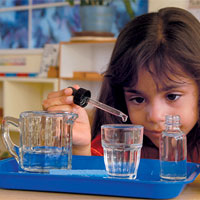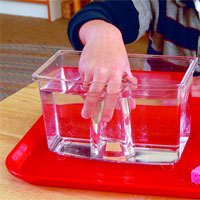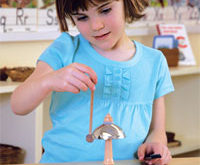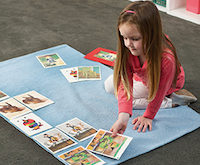 Children naturally absorb the logic and the beauty of physical science as they interact with the environment: pushing a truck up an incline, observing light reflecting on water, or unconsciously witnessing gravity as the rock falls to the ground.
Children naturally absorb the logic and the beauty of physical science as they interact with the environment: pushing a truck up an incline, observing light reflecting on water, or unconsciously witnessing gravity as the rock falls to the ground.
It’s easy for teachers to offer many hands-on science activities so young children can explore how the world works. Give lessons about phenomena children have already noticed, such as sound, heat, friction, magnetism, or surface tension. Later introduce more abstract concepts: naming, classification, and scientific explanations.
Learn While Teaching
You don’t have to be an expert in physics before introducing these lessons. Start with the basics such as sink and float, or magnetic/non-magnetic exercises. As you progress to more advanced lessons, there’s no need to feel intimidated. You can enjoy learning new concepts, or theories long forgotten, alongside the children.
Although few Montessori teacher-training programs include many physical science lessons, there are excellent resources to help you get started. Nurturing the Young Scientist, written by a primary Montessori teacher, has step-by-step activities that will fascinate three- to six-year-olds. The lessons, which give teachers the correct scientific nomenclature, allow children to explore and make basic observations about forms of matter (solid, liquid, gas), forms of energy (light, heat, sound, chemical, magnetic, electrical, simple machines), and the force of gravity. To save you time, Montessori Services has made up a number of kits to accompany the book. For example, there are four activities in one kit to investigate air, with instructions included.
 Many activities in the book can be done with materials you already have in your classroom. For an experiment to help children observe the nature of air, you need a basin filled with water, a toothpick (or small piece of wood), and a glass.
Many activities in the book can be done with materials you already have in your classroom. For an experiment to help children observe the nature of air, you need a basin filled with water, a toothpick (or small piece of wood), and a glass.
- Float the toothpick on the water.
- Put the upside down glass over the toothpick and push down.
- Notice what happens.
- Lift the glass.
- What do you observe? (The air in the glass pushes the toothpick down.)
The Steps of Scientific Inquiry
While younger children will simply want to observe and repeat the activity, five- and six-year-olds enjoy making predictions before doing an experiment and then testing their hypotheses. Nurture the budding scientist by introducing the steps that adult scientists use:
- Observe. (“Here is a shallow, clear plastic box with black pepper sprinkled on the bottom and a lid on the top.”)
- Discuss. (“I wonder what will happen if I rub the lid of the box with a wool scarf?”)
- Make predictions. These can be verbal, written, or a drawn picture. (“I’m guessing that the pepper will…”)
- Perform the experiment.
- Observe. Are the results the same or different from the prediction? (“Oh! The pepper jumped up and stuck to the lid of the box!”)
- Record the results with pictures, words, or both.
- Name the phenomenon. (“This is caused by static electricity.”)
Presenting the Activities
With three-and four-year-olds, present the entire lesson in the traditional Montessori manner and then invite them to choose the work. However, for children ages five and up, it’s important not to show the science activity from beginning to end. Whenever possible, just get children started and encourage them to make their own discoveries.
Fascinating activities for the older child include exploring chemistry (baking soda and vinegar), electricity (building a simple circuit to power a light bulb or buzzer), light (building a periscope), and sound (making a tin can telephone).
Don’t Be Afraid to Be Wrong
Recently I was tutoring a six-year-old child who is being homeschooled. He enjoyed math and language, but was most enthusiastic about physical science experiments. We called science “dessert” and often saved it for last, ending our sessions on a fascinating and joyful note. If I was unfamiliar with the experiment, I would try not to look at the explanation, and would make my prediction alongside the child’s. He especially loved it when I wasn’t correct!
Science and Nature
Whenever possible, take children out to explore physical science in nature. Students can watch leaves float down a river to observe water currents, or sail a walnut shell boat in a puddle to observe the effects of air. They may wonder what causes the sound of rain on the tin roof to be so loud or why the black sand is so much hotter than the white sand in the sunshine.
With the right presentation, access to materials, and opportunity to explore, children will naturally, often unconsciously, begin to comprehend the laws of physics and the nature of the universe. Just as importantly, teachers and children alike can use their imaginations and minds to develop a great love for science and the natural world.
 Montessori blog Montessori blog
Montessori blog Montessori blog

